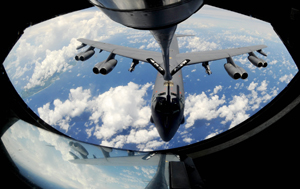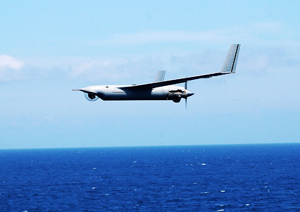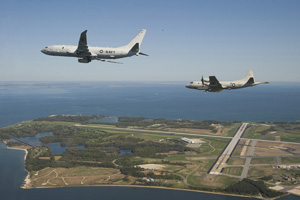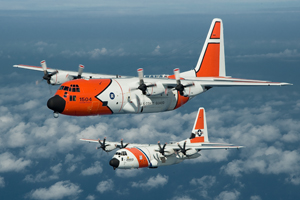Once upon a time, airpower earned its spurs over water. Maritime interdiction—attack of ships—was a major mission for decades. From Billy Mitchell’s sinking of Ostfriesland to the Battle of Midway in 1942, the use of airpower over water made for some dramatic turning points.
During the Cold War, USAF bombers trained to seek and sink warships of the Soviet fleet. Then the Cold War ended and so did open-ocean exercises. The US Navy switched its focus to littoral operations where threats were no greater in size than Iranian coastal patrol boats.
Over the past few years, trends in homeland defense, AirSea Battle, and other operational concepts have brought back the overwater mission’s import. This time, the tasks include long-range surveillance, reconnaissance, and incident response as well as deterrence and strike.
Since 9/11, the threat of terrorist attacks against targets along the US coastline has simmered. The 2008 attacks in Mumbai, India, were another reminder terrorists could exploit relatively open harbors to wreak havoc.
 |
|
“I don’t think there is a generally held consensus about what constitutes an adequate maritime security regime in a postwar, post-9/11 environment,” then-Coast Guard Commandant Adm. Thad Allen said in a 2009 interview with the Christian Science Monitor.
While US air defense has been reconfigured over the last decade, maritime surveillance and security for the 95,000 miles of coastline remains a challenge. Part of the difficulty centers on close-in work, such as detailed mapping of ports and detection of possible threats close to shore. The Coast Guard maintains the Nationwide Automatic Identification System to monitor commercial vessels approaching the coast. Based on an international collision-avoidance system, commercial ships over a certain gross tonnage carry transponders broadcasting the ship name, location, and heading. More than 50 nations share automated identification data via the Web to form a global maritime surveillance system.
For the US, VHF monitoring sites keep track of vessels nearing 58 major US ports. The system receives transmissions at a range of 58 miles and transmits up to 28 miles. Most close-in threats are easily handled by ships and helicopters. The Coast Guard also maintains a fleet of HC-130J and HC-130H aircraft. They provide a key framework for maritime domain awareness, but the Coast Guard is not always enough to sort out the status of suspicious vessels.
Detecting and intercepting such vessels hundreds of miles out to sea is another matter. The worst-case scenarios are sobering: A renegade vessel might pose as a container ship but carry a pod of cruise missiles for launch at US coastal targets, for example. Those missiles might be armed with weapons of mass destruction to target American cities. In this case, action must be taken out at sea—before the vessel closes to within launch distance. This could be several hundred miles from shore.
The Most Effective Tool, for Now
The first role for airpower over water is assisting with detection at much greater ranges. “We now are using B-52s for homeland defense,” said retired Lt. Gen. Robert J. Elder, who commanded USAF’s 8th Air Force. An electro-optical pod enables the B-52 to pick up extremely high-resolution pictures and to follow a target for considerable time. “We go out with some broad area surveillance platforms, and the Navy gives us a ship to locate, based on a signature. We’ve gone out a thousand nautical miles or more off the coast and we find the ship, we put the pod on it, [and] take pictures.”
Once identified, what is the potential response? So far, it’s a question that has come up only in exercises. But there’s a real prospect of having to converge on a vessel and halt it.
The ideal response is for a US Coast Guard cutter or Navy ship to intercept and board a suspect vessel. But ships at sea are limited by speed and manpower. In a major threat scenario with large areas to search, the problem could quickly get out of hand, as Lt. Col. Alexus G. Grynkewich pointed out in a 2007 article for Air and Space Power Journal. Flaws in specific intelligence could compel sea-based forces to board and inspect multiple targets, thereby eating up time.
Intercepts hundreds of miles from the US coast could require direct action by land-based fighters, bombers, or even gunships. One tactic is to halt a suspicious vessel by disabling its screw propeller, for example.
“Aircraft on combat air patrol (CAP)could rapidly engage vessels that emerge as threats as they approach or enter US ports. Command authorities can stand aircraft CAPs up or down and move them to different geographic locations as the threat dictates. Intelligence would determine which ports to defend and how long to maintain the CAP,” wrote Grynkewich.
Ultimately, nonlethal solutions with slower moving platforms such as helicopters or unmanned aerial vehicles would be preferred, according to Grynkewich. In the interim, land-based interceptors might be the only effective tool at hand.
By no means are US coastlines the only hotspots for maritime action. In fact, other areas from the Arctic to the Strait of Malacca are worrying, too. “Once the threat to shipping was submarines; now it’s high-speed boats manned with [rocket-propelled-grenade]-toting pirates and terrorists seizing unarmed merchant shipping,” noted commentator Alan J. Simpson.
 |
The ScanEagle is a small, portable UAV originally designed for commercial maritime work, and now is seeing service in Southwest Asia. (Boeing photo) |
There are several types of potential dustups at sea: defense of territorial waters, access to shipping lanes, protection of diminishing fishing resources, and piracy. “We may be dealing with a 17th century crime, but we need to bring 21st century solutions to bear,” Secretary of State Hillary Rodham Clinton said of counterpiracy efforts.
All responses begin with tracking rogue ships, and this is where USAF airpower can provide the most immediate help. Maritime surveillance was set on the back burner when the Cold War ended. Now, several nations around the world are enhancing maritime surveillance and upgrading their suite of weapons for anti-ship strikes.
The Strait of Malacca is a constant concern for anti-piracy efforts. The 550-mile strait sees more than 50,000 ships transiting through annually, carrying 40 percent of global shipping trade. Among the most precious commodities are nearly 90 percent of Japan’s crude oil supply and as much as 80 percent of China’s.
The strait is a key chokepoint for the US and allies such as Australia, too. “The strait is a vital sea-lane for the US Navy, which sent warships to Taiwan via the Malacca Strait at a time of heightened tensions between China and Taiwan in 1996,” noted Asia expert Bill Tarrant of Reuters.
For now, Singapore, Malaysia, and Indonesia are the primary keepers of peace in the Strait of Malacca. In 2005, those nations launched a successful airborne maritime surveillance program known as Eyes in the Sky. Aircraft such as a C-130, with a combined Malaysian and Singaporean crew, took up the maritime patrol job. Surveillance programs helped downgrade war and piracy risks. “It proves the point that [the characteristics of] airpower can still be effective against nontraditional threats, and combined with proper coordination with civil agencies, can be a very formidable one,” said Malaysian Defense Minister Datuk Seri Ahmad Zahid Hamidi at a 2009 air chiefs conference in the region.
 |
|
The Withering Mission
Eyes in the Sky “demonstrates how regional airpower collaboration can make a decisive impact” on counterpiracy operations, said Jill Lim, spokesman for the Republic of Singapore Air Force.
Many of the surveillance technologies for anti-piracy and other maritime patrol missions fit neatly into bigger contingencies, too. Development of airborne surveillance with inverse synthetic aperture radar (ISAR) is a big help. Inverse SAR uses the movement of the target itself to punch up higher quality resolution, turning a ship from a bright dot to a distinguishable target. ISAR is a main feature of Global Hawks modified for maritime surveillance.
Those same capabilities could come in handy as maritime control and strike again become primary missions for airpower.
Other nations have already embraced maritime strike, whether to deter or prevail, especially in the Asia-Pacific region. Australia underlined a role for maritime strike in its landmark 2009 defense white paper.
For its part, the US is fully engaged with Air Force and Navy teams working all aspects of the new AirSea Battle concept of operations. Fulfilling the maritime control mission has led to a bumper crop of new overwater surveillance aircraft, most operated by the US Navy. The Navy P-8 Poseidon, currently in flight test, will replace its P-3 Orion patrol airplanes. Global Hawk unmanned high-altitude aircraft with sensors modified for overwater operations will join the fleet for the Broad Area Maritime Surveillance mission, also known as BAMS. Smaller UAVs such as ScanEagle already supplement maritime surveillance.
The question of how to best attack ships has returned to the front and center after being headline news in the 1980s. In the Falklands War of 1982, Britain’s Royal Navy lost two warships. HMS Sheffield was felled by an Exocet anti-ship missile, and HMS Coventry succumbed to bomb attack. Several other ships were damaged by cannon fire, bombs, and missiles. Several were later sunk or scrapped.
 |
|
Also in the 1980s, a new emphasis on defeating the Soviet fleet led to fresh Air Force and Navy cooperation. Navy Secretary John F. Lehman welcomed the Air Force to the mission of destroying the Soviet fleet. Soviet Backfire bombers routinely buzzed carriers at sea, so the enthusiasm was real.
War with the Soviets would bring the B-52s and E-3 AWACS together with US Navy ships and aircraft to locate and destroy the Soviet blue water fleet. Ultimately, USAF modified B-52G bombers to carry the Harpoon anti-ship missile.
“Aerospace maritime operations may consist of counterair operations, aerial mine laying, reconnaissance and surveillance, and interdiction of enemy naval surface and subsurface forces, port facilities, and shipping,” stated Air Force doctrine of 1984.
For its part, the Navy experienced ship attack when an Exocet hit USS Stark in May 1987. The next year, US carrier aircraft sunk an Iranian speed boat in Operation Praying Mantis and assisted with sinking a frigate.
By the early 1990s, the ship attack mission withered. The Navy turned away from blue water threats and emphasized brown water, littoral operations, and forward presence from the early 1990s onward.
By the 21st century, observers documented a slow but steady rise in China’s naval presence and overall defense ambitions. Possible interdiction of ships at sea moved up the roster again. Granted, the strategic context was different. Action centered on the Pacific, and US forces expected to face aggressive, land-based air defenses, fighters, and submarine threats. Attack scenarios, however, weren’t about taking out an entire fleet, but targeting hostile vessels attempting to disrupt operations.
 |
The Coast Guard uses HC-130Js like the one flying below the HC-130 for maritime domain awareness. |
For all the emphasis on precision attack, the delicate art of targeting ships at sea had turned into a backwater. The US and NATO partners adopted the Norwegian-designed Penguin missile for launch by helicopters. A new version of the classic Harpoon also debuted.
But the real question was whether precision weapons, stars of land attack, could do the job over water as well. The sequence of events in targeting ships has changed little. Step 1 is to locate the target, and Step 2 is to launch a weapon that will hit it. For weapons launch, the problem is how to ensure the right trajectory to hit a moving target. Larger bombers traditionally did it with accurate bursts causing direct hits or, more often, close hits that cavitated the water around the ship, creating a vacuum pocket followed by a crushing pressure wave. Agile dive-bombers such as those of the US Navy in World War II hit Japanese ships through extreme low-altitude attacks.
Modern day aircrews can rely on far more capable tools. Like the attack of targets on land, the aircrews assigned to find and attack a ship at sea work within a network of reconnaissance, surveillance, and sensor aircraft that perform precision fire-control tracking and pass data to both aircraft and weapons in flight.
USAF put those capabilities to the test dramatically six years ago with the sinking of the decommissioned naval ship Schenectady during the exercise Resultant Fury. The two-day exercise in November 2004 tested the ability of long-range aircraft to find and track multiple ships while under way.
 |
|
Resultant Fury was about proof of concept—with a little signaling to potential adversaries thrown in. The joint exercise was designed to validate the capability to engage and disable ships under way, providing combatant commanders an airpower ability to rapidly conduct maritime interdiction against enemies, Gen. Paul V. Hester, who was Pacific Air Forces commander, said at the time.
The Pacific’s Big Picture
Scanning the ocean for moving targets fell to the Air Force’s E-8C JSTARS aircraft. In the Resultant Fury concept, JSTARS flew orbits to provide the correct angles to establish a targeting track. The track data were handed off via command and control networks to attack aircraft in the area. Resultant Fury tested the ability to detect towed targets and make the handoff to Air Force bombers or Navy F/A-18s. The finale came on Day 2 of the test. A B-52 conducted live fire against a former landing ship, tank—or LST—craft.
“This was the first time ever a B-52 has gone out and dropped self-designated, laser guided weapons on a moving ship,” Maj. Terry Christiansen, who was the B-52 aircraft commander, told the Shreveport (La.) Times. “It’s pretty significant.”
Christiansen described the moment when munitions were propelled off their external rails. “Since we ended up releasing all four simultaneously, 8,000 pounds of weight came off at the same time,” he said. “You feel it.”
Capt. Ronald Wheeler, radar navigator on the same B-52, told the newspaper: “We took off from Barksdale, flew a 20-hour mission, got to the target area on time, and accomplished our objective, which was to sink the ship.”
“To see the LST through the targeting pod I was using to ‘laze’ the ship, to see it blow up in real time, was pretty exciting,” Wheeler added. “Any hostile surface vessel should take heed.”
Bombers are now continuously forward deployed to Guam to deter potential adversaries and reassure allies. “B-52s, B-1s, and B-2s have each taken turns as a continuous sentinel for the Pacific Theater,” said Col. Charles Patnaude, as bombers from 5th Bomb Wing, Minot AFB, N.D., were preparing to deploy in summer 2010.
 |
|
The big picture in the Pacific centers on China’s 260-ship Navy, which includes 75 warships and about 60 submarines. “China has invested decades in a patient and aggressive campaign to slowly push other countries out of the East China Sea and South China Sea,” said James Kraska in The Diplomat in spring 2010. Confrontations at sea over rocky islands and reefs have been occurring since the 1970s, and there are many recorded incidents of Chinese ships harassing US and allied vessels.
Finding, tracking, and attacking ships remains a key deterrent ability. For its part, the US Air Force will be providing the long-range surveillance and striking power over water for the foreseeable future.